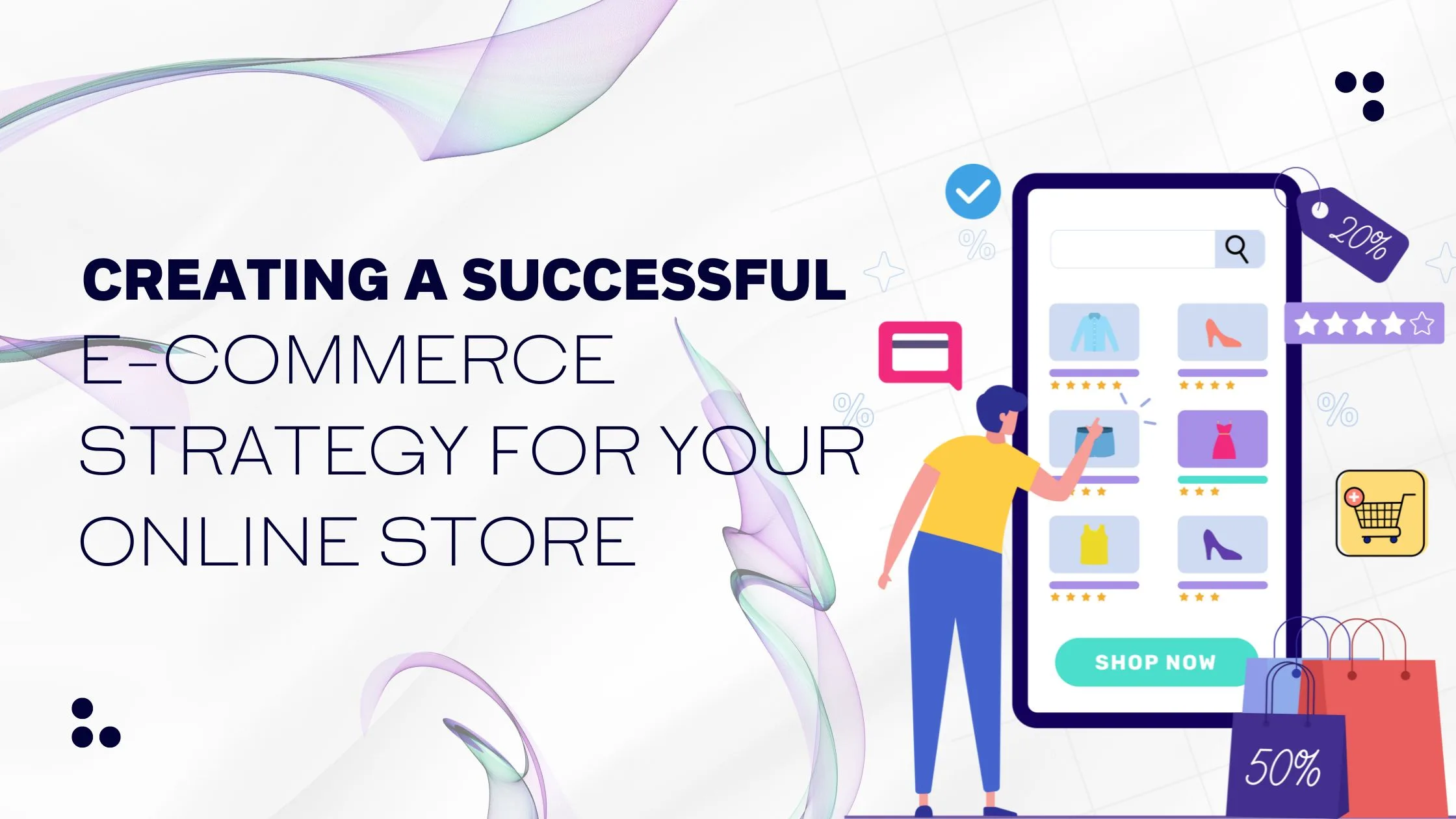Creating a Successful E-commerce Strategy for Your Online Store
Are you ready to unlock the endless potential of your online store? In a world driven by technology and convenience, having a successful e-commerce strategy is crucial for any business. Whether you’re just starting out or looking to revamp your existing online store, this blog post will guide you through the essentials of creating an effective e-commerce strategy that will skyrocket your sales and solidify your brand’s presence in the digital marketplace.
Get ready to ignite your online success as we dive into proven strategies, expert tips, and innovative approaches that will redefine how you do business online!
What is E-commerce and Why is it Important?
E-commerce, short for “electronic commerce,” refers to the buying and selling of goods or services through the internet. It has revolutionized the way businesses operate and has become increasingly important in today’s digital world.
The rise of e-commerce can be attributed to the increasing popularity and accessibility of technology, which has made it possible for consumers to shop online from anywhere at any time. With just a few clicks, shoppers can browse through thousands of products, compare prices, read reviews, make payments and have their purchases delivered right to their doorstep.
So why is e-commerce important for your online store?
1. Global Reach: One major advantage of e-commerce is its ability to reach a global audience. With an online store, you are not limited by geographical boundaries and can potentially sell to customers from all over the world. This opens up endless opportunities for business growth and expansion.
2. Cost-Effective: Setting up an e-commerce store is relatively more cost-effective compared to traditional brick-and-mortar stores. You don’t have to worry about expenses such as rent, utilities, or employee wages. Additionally, with drop-shipping models available, you can even eliminate the need for physical inventory storage.
3. Convenience: E-commerce offers convenience both for business owners and customers alike. As a business owner, you have the flexibility to manage your store from anywhere at any time as long as you have an internet connection. For customers, they can shop 24/7 without having to leave their homes or deal with crowds.
4. Increased Sales and Revenue: With e-commerce, you can potentially reach a larger audience, resulting in increased sales and revenue. Online shopping also allows for targeted marketing and personalized recommendations, which can lead to higher conversion rates.
5. Access to Customer Data: E-commerce enables you to gather valuable data and insights about your customers’ buying behaviors, preferences, and demographics. This information can help you make informed business decisions and tailor your marketing efforts to better target your audience.
In conclusion, e-commerce has transformed the way businesses operate and has become an essential aspect of any successful business strategy. With its global reach, cost-effectiveness, convenience, potential for increased sales and revenue, as well as access to valuable customer data – it is clear why e-commerce is crucial for any business looking to thrive in today’s digital age.
Identifying Your Target Market
Identifying your target market is crucial for any e-commerce strategy to be successful. Your target market refers to the specific group of individuals or businesses that you are targeting with your products or services. These are the people who are most likely to buy from you and who will ultimately determine the success of your online store.
To accurately identify your target market, there are several key factors that need to be considered:
1. Demographics: This includes age, gender, location, income level, education, occupation, and family status. Understanding these basic demographics will give you a clearer picture of who your potential customers are and what their needs and priorities may be.
2. Psychographics: This refers to the attitudes, values, interests, and lifestyles of your target audience. It goes beyond just demographic information and helps you understand the motivations behind their purchasing decisions.
3. Behavior: Studying the buying behavior of your target market can provide valuable insights regarding their preferences in terms of product features or pricing strategies.
4. Pain points: Identifying the pain points or problems that your potential customers face can help you tailor your products or services to meet their needs.
5. Competition analysis: It’s important to also analyze your competitors’ target audience as it can give you an idea of where there might be gaps in the market that you can capitalize on.
Setting Goals for Your Online Store
When it comes to running a successful online store, setting clear and achievable goals is essential. These goals serve as a roadmap for your e-commerce strategy and help you stay focused on what truly matters for the growth of your business. In this section, we will discuss the key factors to consider when setting goals for your online store.
1. Define Your Objectives:
The first step in setting goals for your online store is to define your objectives. These could be anything from increasing sales, expanding customer base, improving website traffic or launching a new product line. It’s important to have a clear understanding of what you want to achieve with your e-commerce business as this will guide the rest of your goal-setting process.
2. Use the SMART Method:
Once you have defined your objectives, use the SMART method (Specific, Measurable, Achievable, Relevant, Time-bound) to create actionable and realistic goals. For example, instead of saying “I want to increase sales”, set a specific target such as “I want to increase sales by 50% in the next quarter”. This makes it easier to track progress towards each goal and helps you evaluate which strategies are working and which ones need improvement.
3. Consider Your Current Situation:
Before finalizing any goals for your online store, it’s crucial to take into account where your business stands currently. Analyze data such as website traffic, conversion rates, average order value and customer retention rate.
Choosing the Right Platform for Your E-commerce Store
When it comes to creating a successful e-commerce strategy, one of the most crucial decisions you will make is choosing the right platform for your online store. Your e-commerce platform is essentially the foundation on which your entire business will run, so it’s important to carefully consider your options and choose one that aligns with your goals and needs.
Here are some key factors to keep in mind when selecting an e-commerce platform:
1. Consider your budget:
The first step in choosing the right platform is determining what you can afford. E-commerce platforms often come with a monthly or yearly subscription fee, as well as transaction fees for each sale made on your website. Make sure to factor these costs into your budget and choose a platform that fits within your financial limitations.
2. Evaluate features:
Different platforms offer different features and functionalities, so it’s essential to evaluate what each one has to offer. Some key features to look out for include inventory management, payment processing options, shipping integrations, SEO tools, and design customization options. Think about which features are crucial for your business and prioritize them while making a decision.
3. Consider scalability:
It’s important to choose an e-commerce platform that can grow with your business over time. As you expand and add more products or services, will the platform be able to accommodate those changes? Make sure to select a solution that offers room for growth and won’t limit you in the future.
4. Assess ease of use:
Running an online store involves numerous tasks like uploading products, managing inventory, and processing orders. The last thing you want is to struggle with a complicated platform every time you need to make updates or changes to your site. Look for an e-commerce solution that is user-friendly and easy to use, even for those without technical skills.
5. Check for integrations:
Integrations allow your e-commerce platform to communicate with other tools and software, making it more versatile and efficient. Be sure to choose a platform that offers integrations with key tools you may need, such as email marketing, accounting, or social media platforms.
6. Consider design options:
The visual appeal of your online store is crucial in attracting and retaining customers. Choose a platform that offers customization options, templates, and themes that align with your brand aesthetic and allow you to create a professional-looking website.
7. Look at customer support:
No matter how user-friendly a platform claims to be, occasional issues or questions may arise while setting up or managing your store. Make sure the e-commerce solution you choose offers reliable customer support so you can get help when needed.
Designing and Branding Your Online Store
Designing and branding your online store is a crucial step in creating a successful e-commerce strategy. It is what sets your business apart from competitors and helps establish a strong and memorable identity for your brand. In this section, we will discuss the key elements of designing and branding your online store.
1. Choose a Platform:
The first step in designing your online store is choosing the right platform to host it. There are various e-commerce platforms available such as Shopify, WooCommerce, Magento, etc. Each platform offers different features and functionalities, so it’s important to choose one that aligns with your business goals and budget.
2. Customizing Your Storefront:
Once you have selected a platform, the next step is to customize your storefront to reflect your brand’s aesthetics. This includes selecting color schemes, fonts, images, and layout that resonate with your target audience. Make sure to keep the design simple yet visually appealing as cluttered websites can be overwhelming for customers.
3. Create an Eye-Catching Logo:
Your logo is the face of your brand and plays a significant role in establishing its identity. Invest time in creating a unique and creative logo that represents your brand values and resonates with your target audience.
4. Write Compelling Product Descriptions:
When it comes to branding an online store, product descriptions play a vital role in attracting customers’ attention towards products on display. Along with providing accurate information about the product, make sure to sprinkle some creativity into the description by using persuasive language .
Implementing SEO Strategies for Increased Visibility
In today’s digital age, having a strong online presence is crucial for the success of any e-commerce store. One way to achieve this is by implementing effective Search Engine Optimization (SEO) strategies. SEO plays a crucial role in increasing visibility, driving traffic, and ultimately boosting sales for your online store.
Here are some essential tips for implementing SEO strategies to increase the visibility of your e-commerce store:
1. Conduct Keyword Research: The first step in any SEO strategy is conducting thorough keyword research. It involves identifying relevant keywords that your target audience is most likely to use when searching for products or services similar to yours. Use tools like Google Keyword Planner or SEMrush to identify high-ranking keywords with low competition.
2. Optimize Your On-Page Content: Once you have your list of keywords, it’s time to optimize your on-page content. This includes using targeted keywords in your page titles, headings, meta descriptions, and product descriptions. However, make sure to use keywords naturally and avoid overstuffing.
3. Improve Your Website Speed: Website speed is a critical factor in SEO rankings. A slow website can significantly impact user experience and lead to a higher bounce rate. Use tools like Google PageSpeed Insights or GTmetrix to analyze your website’s speed and make necessary optimizations.
4. Optimize for Mobile: With more and more people using their mobile devices for online shopping, having a mobile-friendly website is crucial for e-commerce success. Make sure your website is optimized for mobile devices and provides a seamless user experience.
5. Build Quality Backlinks: Backlinks are links from other websites that direct to your online store. They act as votes of confidence from other sites, indicating that your content is relevant and authoritative. Focus on creating high-quality backlinks from reputable websites through guest blogging, influencer outreach, or partnerships with other businesses.
6. Utilize Social Media: Social media platforms can also play a significant role in driving traffic and boosting visibility for your e-commerce store.
Creating a User-Friendly Shopping Experience
Creating a User-Friendly Shopping Experience is key to the success of any e-commerce strategy. Customers are looking for convenience, efficiency, and ease when shopping online. By creating a user-friendly shopping experience, you can attract and retain customers, increase sales, and ultimately grow your online store.
In this section, we will explore some essential elements that contribute to a user-friendly shopping experience:
1. Intuitive Website Design:
The first step in creating a user-friendly shopping experience is to have a well-designed website. Your website should be easy to navigate with clear categories and product pages. Use high-quality images and descriptive product descriptions to help customers make informed purchasing decisions.
It’s also important to have a responsive design that adapts to different devices such as mobile phones or tablets. This ensures that your website looks great on all devices, making it easier for customers to shop from anywhere.
2. Simple Checkout Process:
Complicated checkout processes are one of the main reasons why customers abandon their purchases. To prevent this from happening on your online store, make sure your checkout process is simple and streamlined.
Allow customers to check out as guests without creating an account if they choose so. Offer multiple payment options including credit/debit cards, PayPal or Apple Pay. Also, provide them with the option to save their billing and shipping information for future purchases for faster transactions.
3. Fast Loading Speeds:
In today’s fast-paced world, no one has the patience for slow loading websites. A slow website not only annoys customers, but it also affects your website’s search engine ranking. To ensure a positive shopping experience for your customers, optimize your website’s loading speed by minimizing image and video sizes, leveraging browser caching, and using a reliable web hosting service.
4. Search Functionality:
Implementing a robust search functionality allows customers to quickly find what they are looking for. Make sure to have an easy-to-find search bar prominently displayed on every page. Allow customers to filter their searches based on categories, price range, or any other relevant options.
5. Clear Return Policy:
A clear and customer-friendly return policy gives customers confidence in their purchase. Ensure that your return policy is easy to understand and is prominently displayed on your website so that customers can find it easily if needed.
6. Personalized Recommendations:
Personalizing the shopping experience can significantly enhance customer satisfaction. Use data from past purchases or browsing history to recommend related products or suggest items that other customers with similar interests have bought.
7. Customer Reviews and Ratings:
Customer reviews and ratings are essential for building trust with potential buyers and encouraging them to make a purchase decision. Make it easy for customers to leave reviews by sending follow-up emails after the purchase or having a designated section on the product page.
Utilizing Social Media to Promote Your Online Store
In today’s digital landscape, social media has become a powerful tool for businesses of all sizes to promote their products or services and connect with their target audience. This rings especially true for e-commerce businesses, as social media offers a highly effective and cost-efficient way to reach potential customers. In fact, according to research from Sprout Social, 75% of people have purchased something because they saw it on social media.
As an online store owner, leveraging the power of social media is crucial in developing a successful e-commerce strategy. By utilizing various platforms such as Facebook, Instagram, Twitter, and LinkedIn, you can effectively drive traffic to your online store and increase your sales. Here are some tips for using social media to promote your online store:
1. Identify Your Target Audience: Before jumping into promoting your online store on social media, it’s crucial to identify your target audience first. Who are the people that are most interested in your products or services? What demographic do they fall under? Understanding your target audience will help you tailor your content and choose the right platforms to focus on.
2. Choose the Right Platform(s): With so many different social media platforms available, it can be overwhelming trying to figure out which ones would be best for promoting your online store. The key is to understand where your target audience spends most of their time and which platform aligns with your brand’s image and voice.
Evaluating and Adjusting Your Strategy for Constant Growth
Evaluating and adjusting your strategy is a crucial aspect of creating a successful e-commerce strategy for your online store. In the fast-paced world of e-commerce, it is essential to continuously monitor and analyze your performance in order to identify areas for improvement and make necessary adjustments to ensure constant growth.
1. Establish key performance indicators (KPIs)
The first step towards evaluating your strategy is defining clear and measurable KPIs that align with your business objectives. These may include metrics such as website traffic, conversion rates, average order value, customer acquisition costs, and lifetime value. By establishing these KPIs, you can track your progress and determine which areas of your strategy need to be reassessed.
2. Monitor website analytics
Your website’s analytics are a goldmine of data that can provide valuable insights into user behavior, preferences, and patterns. By regularly monitoring this data, you can identify which pages are performing well and which ones need improvement. This information can help you make informed decisions when adjusting your strategy.
3. Conduct A/B testing
A/B testing involves comparing two versions of a webpage or element on your website to see which one performs better in terms of achieving the desired outcome. This type of testing allows you to experiment with different layouts, designs, copywriting techniques, or call-to-action buttons to see what resonates best with your audience. By conducting A/B tests regularly, you can fine-tune elements of your strategy for maximum effectiveness.
4. Analyze customer feedback
Pay attention to what your customers are saying about your products, services, and overall shopping experience. Encourage them to leave reviews and ratings, and use this feedback to identify areas of improvement. Additionally, consider sending out surveys to gather more detailed feedback from your customers. This information can provide valuable insights into your strengths and weaknesses as an e-commerce business.
5. Stay updated on industry trends
The e-commerce industry is constantly evolving, and it’s crucial to stay updated on the latest trends, technologies, and consumer behavior. Keep an eye on what your competitors are doing and research new strategies or tactics that you could adopt in your own business. By staying updated on industry developments, you can ensure that your strategy remains relevant and competitive.
6. Be prepared to pivot
Despite careful planning, unexpected challenges or opportunities may arise that require you to make significant changes to your strategy. It’s essential to be flexible and willing to pivot quickly if needed. Continuously reassessing your strategy allows you to adapt to changes in the market and maintain a competitive edge.
In conclusion, evaluating and adjusting your e-commerce strategy is an ongoing process that requires constant monitoring, analysis, and adaptation.
Conclusion: The Importance of Continual Adaptation
In today’s constantly evolving e-commerce landscape, it is essential for businesses to adapt and evolve in order to stay relevant and successful. E-commerce is not a one-time project, but rather an ongoing process that requires continual adaptation in order to meet the ever-changing needs and preferences of consumers.
The importance of continual adaptation cannot be overstated when it comes to creating a successful e-commerce strategy for your online store. It is crucial for businesses to regularly assess their strategies and make necessary changes in order to keep up with the rapidly changing market trends, consumer behaviors, and technological advancements.





